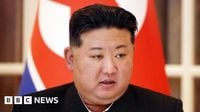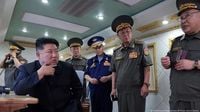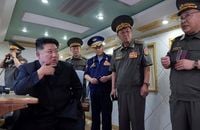North Korea’s military ambitions took center stage again on August 23, 2025, as leader Kim Jong-un supervised the test-firing of two newly developed surface-to-air missiles, a move that has drawn the world’s attention and heightened tensions on the Korean Peninsula. According to multiple state media outlets, including the Korean Central News Agency (KCNA), the test was designed to demonstrate the missiles’ improved performance and combat capabilities against a range of aerial threats, from attack drones to cruise missiles.
The launches, carried out by North Korea’s Missile Administration, took place amid an already charged atmosphere, coinciding with the ongoing Ulchi Freedom Shield joint military exercises between South Korea and the United States. These annual drills, which began on August 18 and are set to run for 11 days, are routinely condemned by Pyongyang as provocative. This year has proven no different, with Kim Jong-un and his inner circle ramping up their rhetoric. As reported by Yonhap, Kim previously denounced the exercises as an expression of the allies’ intent to “ignite a war,” while his influential sister, Kim Yo-jong, dismissed South Korean President Lee Jae Myung’s efforts at reconciliation as futile.
The KCNA, as cited by BBC and other international outlets, was effusive about the results of the test, claiming that the missiles’ “unique and special technology” gave them “superior combat capability” and made them “very suitable for destroying various aerial targets.” The agency did not specify the exact models of the missiles or the precise location of the launch, but emphasized that their operation and reaction modes set them apart from previous systems. State media also reported that Kim Jong-un, accompanied by senior party and military officials including Air Force Commander Marshal Kim Kwang-hyok, “assigned an important task” to the country’s defense science sector, hinting at further military developments ahead of a key party session.
While North Korea’s claims about its missile technology are often difficult to independently verify, the timing and context of the launch are unmistakable. The test occurred just hours after South Korea’s military fired warning shots at about 30 North Korean soldiers who briefly crossed the heavily fortified Demilitarized Zone (DMZ) separating the two countries. The United Nations Command confirmed the incident, and North Korean state media quickly labeled the border crossing a “premeditated and deliberate provocation.” Army Lieutenant General Ko Jong Chol was quoted by state media as warning, “This is a very serious prelude that would inevitably drive the situation in the southern border area, where a huge number of forces are stationed in confrontation with each other, to the uncontrollable phase.”
The test-firing also coincided with a flurry of diplomatic activity in the region. South Korean President Lee Jae Myung was in Tokyo for a summit with Japanese Prime Minister Shigeru Ishiba, where both leaders pledged to strengthen bilateral cooperation and deepen their trilateral partnership with the United States, specifically to address North Korea’s nuclear ambitions. President Lee was scheduled to depart for Washington on August 24 for a summit with U.S. President Donald Trump, underscoring the high stakes and the international dimension of the Korean Peninsula’s security dilemma.
Kim Jong-un’s government has made it clear that it has little interest in restarting negotiations with Seoul or Washington aimed at winding down its nuclear weapons and missile programs. Instead, Pyongyang has prioritized expanding ties with nations opposed to the United States, most notably Russia. Since Russia’s invasion of Ukraine, North Korea has reportedly sent thousands of troops and significant quantities of artillery and ballistic missiles to support President Vladimir Putin’s war effort. South Korean intelligence estimates that about 15,000 North Korean troops have been deployed to Russia since last fall, with approximately 600 casualties reported. Kim recently held a ceremony in Pyongyang to honor North Korean soldiers who fought in Ukraine, awarding state “hero” titles and placing medals beside 101 portraits of the fallen, whom he hailed as “great men, great heroes and great patriots.”
There are growing concerns in Seoul and among Western analysts that Moscow could be providing North Korea with advanced military technology in return for its support. South Korea’s previous conservative administration revealed in November 2024 that Russia had delivered missiles and other equipment to reinforce air defenses around Pyongyang, though the specific systems were not identified. Experts have pointed to North Korea’s aging antiair and radar systems as likely areas for Russian assistance, and questions remain as to whether the latest missiles tested by North Korea incorporated any Russian technology. As reported by BBC, “Whether the latest missiles fired by North Korea involved any Russian technology was unclear.”
Kim’s foreign policy approach has been characterized by a willingness to deepen ties with Moscow and other countries challenging the U.S.-led international order. Beyond sending troops and weapons, Kim has also agreed to dispatch thousands of military construction workers and deminers to Russia’s Kursk region, a deployment that South Korean intelligence believes could happen soon. This deepening North Korea-Russia relationship is viewed by many as a strategic move to bolster Pyongyang’s own military capabilities while countering international isolation.
Meanwhile, the North’s domestic messaging remains defiant. Earlier in August, Kim Jong-un condemned the U.S.-South Korea joint military drills as “most hostile and confrontational,” and he vowed to accelerate the country’s nuclear weapons development. In January 2025, North Korea claimed to have successfully fired a new intermediate-range ballistic missile equipped with a hypersonic warhead, which state media boasted “will reliably contain any rivals in the Pacific region.”
President Lee Jae Myung, who took office in June 2025, has called for warmer ties with North Korea and pledged to build “military trust.” However, Pyongyang has so far dismissed these overtures, with Kim’s sister Kim Yo-jong publicly rebuffing Lee’s efforts to change the course of history. The North’s repeated missile tests and military maneuvers send a clear message that it intends to continue strengthening its military, regardless of diplomatic outreach from Seoul or Washington.
The events of August 23, 2025, serve as a stark reminder that the Korean Peninsula remains one of the world’s most volatile flashpoints. With both sides engaged in military posturing and diplomatic maneuvering, and with new alliances and technologies potentially shifting the balance of power, the prospects for peace and stability remain uncertain. For now, Kim Jong-un’s latest missile test has added another layer of complexity to an already fraught regional security landscape.



